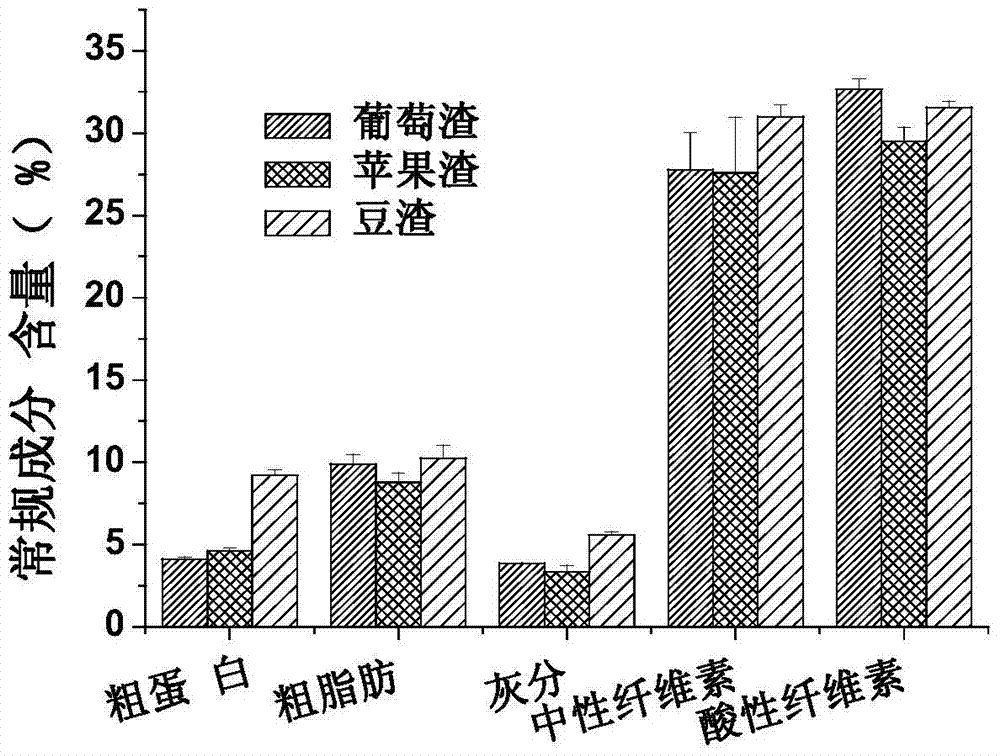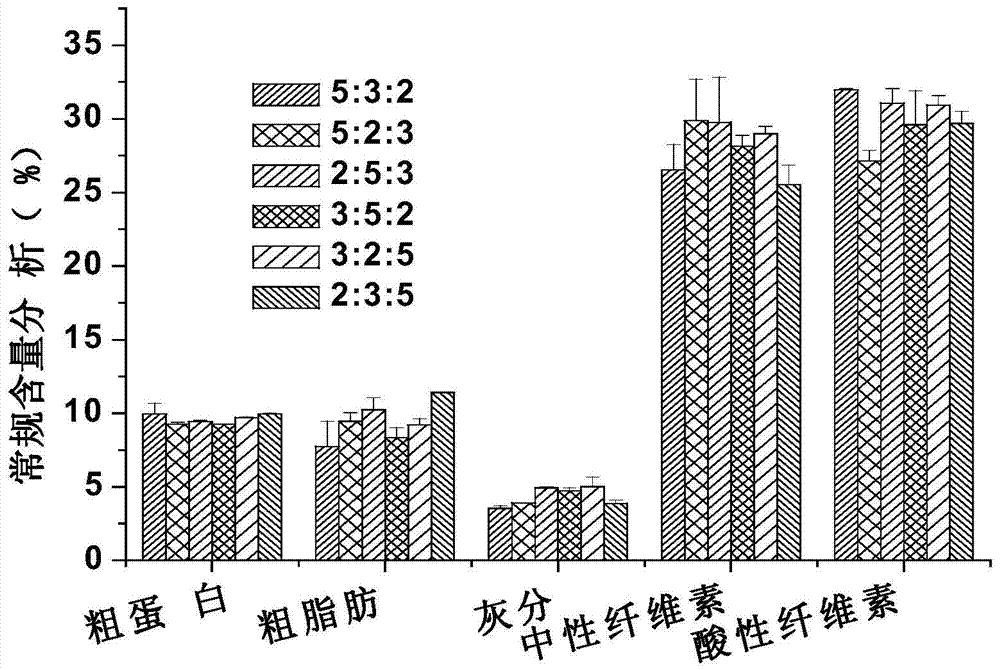A kind of compound protein feed and preparation method thereof
A compound protein and feed technology, applied in the field of compound protein feed and its preparation, can solve the problems of few studies on nutritional value evaluation of fermented products, no systematic research on fermentation substrates, lack of system parameters, etc., so as to reduce the cost of feed and improve the Inferior quality, the effect of improving economic efficiency
- Summary
- Abstract
- Description
- Claims
- Application Information
AI Technical Summary
Problems solved by technology
Method used
Image
Examples
Embodiment 1
[0036] Example 1 Fermentation substrate screening of compound protein feed
[0037] 1. Determination and comparison of various conventional components of the matrix
[0038] made by experiment figure 1 It can be concluded that crude protein content: okara > apple pomace > grape pomace; crude fat content: okara > grape pomace > apple pomace; ash content: okara > grape pomace > apple pomace; neutral cellulose content: okara > grape pomace > Apple pomace; acidic cellulose content: grape pomace > bean pomace > apple pomace, it is planned to use bean pomace as the main ingredient, and apple pomace and grape pomace as auxiliary materials, which is conducive to the complementary effect of conventional nutrients.
[0039] 2. Determination of the ratio of the matrix and the determination of conventional nutritional components
[0040] Dried bean dregs, apple pomace, and grape pomace at 105°C to constant weight, weighed an appropriate amount of the above-mentioned samples, mixed them ...
Embodiment 2
[0043]Example 2 Fermentation enzyme combination screening of compound protein feed
[0044] In the experiment, the compound protein feed (the ratio of the substrate is selected as grape pomace: apple pomace: okara is 2:3:5) was used as the fermentation material for the fermentation experiment. Two microorganisms were selected for the experiment: Saccharomyces cerevisiae and Lactobacillus, and an enzyme solution : Cellulase, for fermentation experiments. Six groups of experiments were designed for the combined screening experiment of bacterial enzymes, namely: blank mixed matrix, fermentation of S. Mass ratio 1:1), Saccharomyces cerevisiae fermentation + Lactobacillus + cellulase fermentation [Saccharomyces cerevisiae fermentation + Lactobacillus, each 2.5%) total 5%, cellulase 5%]. All experiments were fermented for 24 hours at 30°C and the inoculum size was 10%. Finally, the conventional component content of the fermentation product was determined.
[0045] After different...
Embodiment 3
[0047] Example 3 Fermentation Condition Optimization of Compound Protein Feed
[0048] 1. Determination of fermentation temperature
[0049] In the experiment, the compound protein feed (the ratio of the matrix is selected as grape pomace: apple pomace: bean dregs is 2:3:5) was used as the fermentation material for the fermentation experiment. Three groups of experiments were designed for the fermentation temperature determination experiment, respectively: 30°C, 32.5 ℃, 35℃. The enzyme conditions of all experimental bacteria are: Saccharomyces cerevisiae fermentation + Lactobacillus + cellulase (Saccharomyces cerevisiae fermentation: Lactobacillus mass ratio = 1:1, the inoculum amount of the two is 5% in total, and the amount of cellulase added is 5%). The process is all within 24 hours. Finally, the conventional component content of the fermentation product was determined.
[0050] After different fermentation temperatures and routine component determination of fermentat...
PUM
 Login to View More
Login to View More Abstract
Description
Claims
Application Information
 Login to View More
Login to View More - R&D
- Intellectual Property
- Life Sciences
- Materials
- Tech Scout
- Unparalleled Data Quality
- Higher Quality Content
- 60% Fewer Hallucinations
Browse by: Latest US Patents, China's latest patents, Technical Efficacy Thesaurus, Application Domain, Technology Topic, Popular Technical Reports.
© 2025 PatSnap. All rights reserved.Legal|Privacy policy|Modern Slavery Act Transparency Statement|Sitemap|About US| Contact US: help@patsnap.com



